Basics of Peforming Drainage Simulations with and without Gravity#
The PMEAL team recently developed a way to add gravitational effects to the standard drainage simulation algorithm based on sphere insertion, also sometimes called morphological image opening or full morphology. The paper is available in Water Resources Research. This post will give a brief overview of how to use this new algorithm, which is included in a new function called drainage located in the porespy.filters module. The new drainage function can produce results with or without gravity effects, creating a more powerful yet flexible function for performing such simulations.
import matplotlib.pyplot as plt
import numpy as np
from edt import edt
import porespy as ps
ps.visualization.set_mpl_style()
Start by generating a 2D image of blobs:
np.random.rand(0)
im = ps.generators.blobs([1000, 1000], porosity=0.7, blobiness=2, seed=0)
ps.imshow(im);
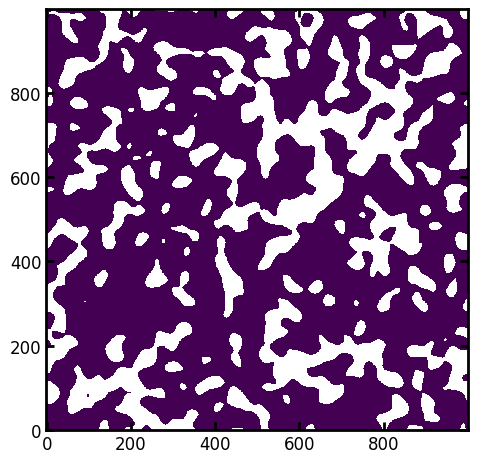
First we’ll compute a reference capillary pressure curve with no gravity effects using the drainage function. This function requires us to supply an image of capillary pressure values associated with each voxel. Typicall one would use the Washburn equation:
where r is conveniently provided by the distance transfer. This can be computed as follows:
voxel_size = 1e-4 # m/voxel side, a large value is used illustrate the gravity effect
dt = edt(im) # Obtain the distance transform, using the terrific edt package
pc = -2 * 0.072 * np.cos(np.deg2rad(180)) / (dt * voxel_size) # Apply Washburn equation
The reason for requiring pc instead of just the boolean im is to allow users to compute the capillary pressure using any method they wish. For instance a 2D image of a glass micromodel has a spacing between the plates which can be accounted for as:
Or s could be set to np.inf for a truly 2D simulation. Computing pc externally also reduces the number of arguments that must be sent to the drainage function, by eliminating the surface tension and contact angle.
In any event, the function is called as follows:
inlets = np.zeros_like(im)
inlets[0, ...] = True
drn = ps.simulations.drainage(pc=pc, im=im, inlets=inlets, steps=25)
fig, ax = plt.subplots(1, 2, figsize=[7, 14])
ax[0].imshow(drn.im_pc / im, origin="lower", interpolation="none")
ax[1].imshow(np.log10(drn.im_pc), origin="lower", interpolation="none");
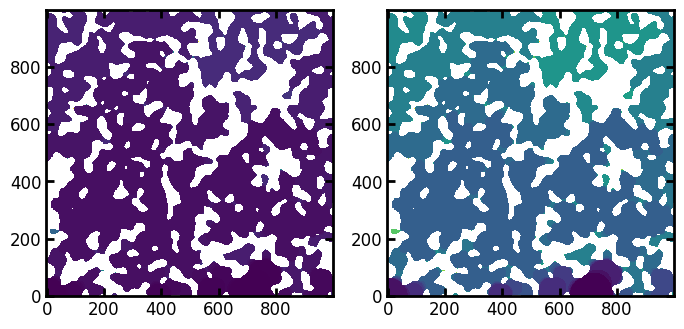
Both of the above images are colored according to the capillary pressure at which a given voxel was invaded. In the right image we have applied a base-10 logarithm to the values to improve visibility. The format is handy since it contains the entire invasion sequence in a single image.
Note that we have divided the image of invasion pressures by
imto trick matplotlib into showing the solid as white, sincevalue/Falsereturnsnanwhilevalue/Trueleavesvalueuntouched.
Next let’s produce a capillary pressure curve. There are some functions available in porespy.metrics for this, but the drainage function takes care of this for us and the needed values are attached to the returned object as attributes:
Pc, Snwp = ps.metrics.pc_map_to_pc_curve(
im=im,
pc=drn.im_pc,
mode="drainage",
)
plt.plot(Pc, Snwp, "b-o")
plt.xlabel("Capillary Pressure [Pa]")
plt.ylabel("Non-wetting Phase Saturation");
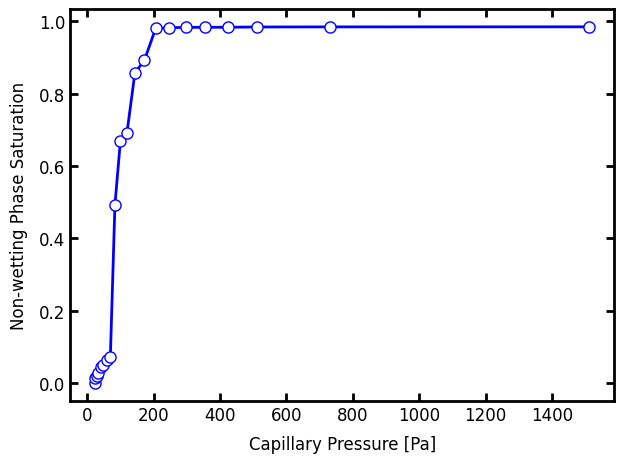
Now let’s perform the same experiment but including the gravity effects, by setting g to earth’s gravity:
pc = ps.filters.capillary_transform(
im=im,
sigma=0.072,
theta=180,
rho_nwp=1000,
rho_wp=0,
g=9.81,
voxel_size=voxel_size,
)
drn2 = ps.simulations.drainage(pc=pc, im=im, inlets=inlets, steps=25)
fig, ax = plt.subplots(1, 2, figsize=[7, 14])
ax[0].imshow(drn2.im_pc / im, origin="lower", interpolation="none")
ax[1].imshow(np.log10(drn2.im_pc), origin="lower", interpolation="none");

We can see from the colormap that the invasion pattern is different. Plotting the capillary pressure curve will make the differences more obvious:
Pc2, Snwp2 = ps.metrics.pc_map_to_pc_curve(
im=im,
pc=drn2.im_pc,
mode="drainage",
)
plt.plot(Pc2, Snwp2, "r-o")
plt.xlabel("Capillary Pressure [Pa]")
plt.ylabel("Non-wetting Phase Saturation");
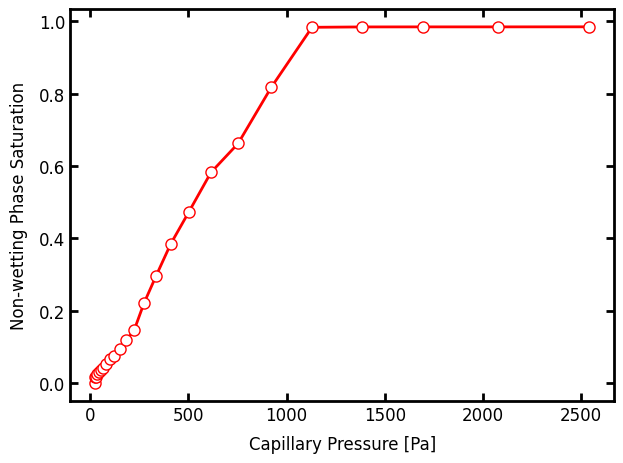
Combining both plots together for a better comparison:
plt.plot(Pc, Snwp, "b-o")
plt.plot(Pc2, Snwp2, "r-o")
plt.xlabel("Capillary Pressure [Pa]")
plt.ylabel("Non-wetting Phase Saturation");
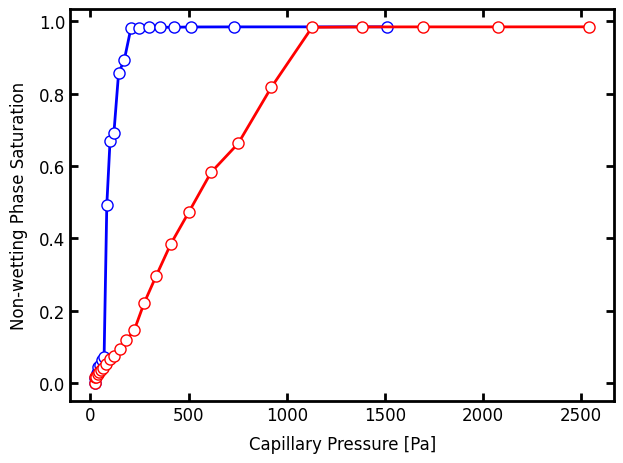
The red curve above is shifted to the right with a lower slope. This is the expected result since the impact of gravity makes it more difficult for the heavy non-wetting fluid to rise up the domain and penetrate into pores. The decreased slope is also expected since pores are invaded more gradually rather than in a larger percolation event.
